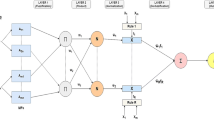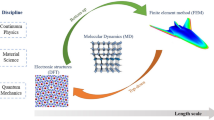Abstract
This paper proposed an automated optimization method to improve the prediction accuracy of thermal finite element analysis for laser welding. The method used particle swarm optimization (PSO) to find the optimal heat source parameters with the minimum prediction error, and the PSO was improved with a boundary mutation strategy of attenuation reflection. To improve the optimization speed, the effects of model geometry and latent heat on the prediction accuracy and solution speed of thermal analysis were studied. The results showed that the reduced 3/50-length model could increase the solution speed with a speed-up of 137 times and had the same predicted results as the full model. The latent heat could increase the nonlinearity, and thus gave rise to a speed-down of 4 times in solution speed but a decrease of 6.06% in prediction error. Therefore, a reduced 3/50-length model considering the latent heat was used in the optimization. The parameter optimization was first performed in the thermal analysis using a welding speed of 2.4 m/min, and then the optimized optimal parameters were used at other 5 speeds. The results showed that the error function of the parameters was a multi-peak function. In addition, it could be seen that the maximum, minimum, and mean errors of the weld cross sections were 9.47%, 4.36%, and 6.81% respectively, while the errors using the trial and error method were 12.48%, 7.20%, and 9.98% respectively. This indicated that the proposed method had a speed-up of about 6 times and higher prediction accuracy.










Similar content being viewed by others
Availability of data and materials
All data generated or analyzed during the present study are included in this published article.
Code availability
Not applicable.
Abbreviations
- [X min, X max]:
-
Position feasible region
- [V min, V max]:
-
Speed feasible region
- X i :
-
Particle position
- V i :
-
Particle speed
- n :
-
Particle number
- d :
-
Particle dimension
- λ :
-
Attenuation coefficient
- \(\Delta\) :
-
Predicted error
- w i :
-
Experimental upper/bottom/waist widths
- l i :
-
Predicted upper/bottom/waist widths
- \(p_{id}^{m}\) :
-
Individual extreme value
- \(p_{gd}^{m}\) :
-
Global extreme value
- ρ(T) :
-
Density
- k(T) :
-
Thermal conductivity
- \(C_{p}^{eqv} (T)\) :
-
Equivalent specific heat capacity
- \(q_{0} (x,y,z)\) :
-
Heat source model
- Q L :
-
Laser power
- Q L 1 :
-
Laser power of the upper heat source
- Q L 2 :
-
Laser power of the bottom heat source
- λ :
-
Welding efficiency
- r 0 :
-
Heat source radius
- H :
-
Sheet thickness
- h 1 :
-
Height of the upper heat source
- h 2 :
-
Height of the bottom heat source
- f 1 :
-
Radius coefficient
- f 2 :
-
Decay index of heat flux in thickness direction
- a :
-
Inclination angle of heat source
- h c :
-
Equivalent heat transfer coefficient
- \(\varphi_{i}\) :
-
Volume fraction of each phase
- \(H_{i} \left( T \right)\) :
-
Enthalpy of each solid phase
- \(\dot{{\varphi }_{1}}\) :
-
Austenite formation rate
- \(\varphi_{eq}\) :
-
Equilibrium volume fraction of austenite
- \(\tau\) :
-
Time required for equilibrium
References
Hamelin CJ, Murnsky O, Smith MC et al (2014) Validation of a numerical model used to predict phase distribution and residual stress in ferritic steel weldments. Acta Mater 75:1–19. https://doi.org/10.1016/j.actamat.2014.04.045
Chambonneau M, Li Q, Fedorov VY et al (2021) Taming ultrafast laser filaments for optimized semiconductor–metal welding. Laser Photonics Rev 15:1–7. https://doi.org/10.1002/lpor.202000433
Zang Z, Zeng X, Du J et al (2016) Femtosecond laser direct writing of microholes on roughened ZnO for output power enhancement of InGaN light-emitting diodes. Opt Lett 41:3463. https://doi.org/10.1364/ol.41.003463
Tan D, Zhang B, Qiu J (2021) Ultrafast laser direct writing in glass: thermal accumulation engineering and applications. Laser Photonics Rev 15:1–22. https://doi.org/10.1002/lpor.202000455
Wu Z, Dong Y, Zhang S et al (2021) Discussion on effect of laser parameters and trajectory in combined pulse laser drilling. Int J Hydromechatronics 4:43. https://doi.org/10.1504/ijhm.2021.114175
Analysis P, Deformation P, Control I, Based S (2021) Performance analysis of plastic deformation inertial control switch based on 3D printing. J Ordnance Equip Eng 42:244–249
Meara NO (2015) Developing material models for use in finite element predictions of residual stresses in ferritic steel welds. Manchester University
Sun J, Hensel J, Klassen J et al (2019) Solid-state phase transformation and strain hardening on the residual stresses in S355 steel weldments. J Mater Process Technol 265:173–184. https://doi.org/10.1016/j.jmatprotec.2018.10.018
Rong Y, Xu J, Huang Y, Zhang G (2018) Review on finite element analysis of welding deformation and residual stress. Sci Technol Weld Join 23:198–208. https://doi.org/10.1080/13621718.2017.1361673
Rong Y, Mi G, Xu J et al (2018) Laser penetration welding of ship steel EH36: a new heat source and application to predict residual stress considering martensite phase transformation. Mar Struct 61:256–267. https://doi.org/10.1016/j.marstruc.2018.06.003
Chen W, Xu L, Zhao L et al (2020) Thermo-mechanical-metallurgical modeling and validation for ferritic steel weldments. J Constr Steel Res 166:105948. https://doi.org/10.1016/j.jcsr.2020.105948
Artinov A, Bachmann M, Rethmeier M (2018) Equivalent heat source approach in a 3D transient heat transfer simulation of full-penetration high power laser beam welding of thick metal plates. Int J Heat Mass Transf 122:1003–1013. https://doi.org/10.1016/j.ijheatmasstransfer.2018.02.058
Rosenthal D (1941) Mathematical theory of heat distribution during welding and cutting. Weld J 20:220–234
Eagar TW, Tsai NS (1983) Temperature fields produced by traveling distributed heat sources. Weld J (Miami, Fla) 62:346–355
Sonti N, Amateau MF (1989) Finite element modeling of heat flow in deep penetration laser welds in aluminum alloy. Numer Heat Transf Part A 16:351–378
Goldak J, Chakravarti A, Bibby M (1984) A new finite element model for welding heat sources. Metall Trans B 52:1–7. https://doi.org/10.1080/21681805.2017.1363816
Wu S, Zhao H, Wang Y, Zhang X (2004) A new heat source model in numerical simulation of high energy beam welding. Trans China Weld Inst 25:92–94
Xu G, Wu C, Qin G et al (2008) Numerical simulation of weld formation in laser plus GMAW hybrid welding. ACTA Metall Sin 44:478–482
Chang WS, Na SJ (2002) A study on the prediction of the laser weld shape with varying heat source equations and the thermal distortion of a small structure in micro-joining. J Mater Process Technol 120:208–214. https://doi.org/10.1016/S0924-0136(01)00716-6
Singh B, Singhal P, Saxena KK, Saxena RK (2021) Influences of latent heat on temperature field, weld bead dimensions and melting efficiency during welding simulation. Met Mater Int 27:2848–2866. https://doi.org/10.1007/s12540-020-00638-4
Chang B, Allen C, Blackburn J et al (2015) Fluid Flow characteristics and porosity behavior in full penetration laser welding of a titanium alloy. Metall Mater Trans B Process Metall Mater Process Sci 46:906–918. https://doi.org/10.1007/s11663-014-0242-5
Zhang LJ, Zhang JX, Gumenyuk A et al (2014) Numerical simulation of full penetration laser welding of thick steel plate with high power high brightness laser. J Mater Process Technol 214:1710–1720. https://doi.org/10.1016/j.jmatprotec.2014.03.016
Zhang LJ, Zhang GF, Bai XY et al (2016) Effect of the process parameters on the three-dimensional shape of molten pool during full-penetration laser welding process. Int J Adv Manuf Technol 86:1273–1286. https://doi.org/10.1007/s00170-015-8249-x
Wang J, Han J, Domblesky JP et al (2016) Development of a new combined heat source model for welding based on a polynomial curve fit of the experimental fusion line. Int J Adv Manuf Technol 87:1985–1997. https://doi.org/10.1007/s00170-016-8587-3
Farrokhi F, Endelt B, Kristiansen M (2019) A numerical model for full and partial penetration hybrid laser welding of thick-section steels. Opt Laser Technol 111:671–686. https://doi.org/10.1016/j.optlastec.2018.08.059
Rong Y, Wang L, Wu R, Xu J (2022) Visualization and simulation of 1700MS sheet laser welding based on three-dimensional geometries of weld pool and keyhole. Int J Therm Sci 171:107257. https://doi.org/10.1016/j.ijthermalsci.2021.107257
Zhan X, Mi G, Zhang Q et al (2017) The hourglass-like heat source model and its application for laser beam welding of 6 mm thickness 1060 steel. Int J Adv Manuf Technol 88:2537–2546. https://doi.org/10.1007/s00170-016-8797-8
Cheon J, Na SJ (2016) Influence of simulation methods of temperature distribution on thermal and metallurgical characteristics in GMA welding. Mater Des 108:183–194. https://doi.org/10.1016/j.matdes.2016.06.090
Sun J, Liu X, Tong Y, Deng D (2014) A comparative study on welding temperature fields, residual stress distributions and deformations induced by laser beam welding and CO2 gas arc welding. Mater Des 63:519–530. https://doi.org/10.1016/j.matdes.2014.06.057
Rouquette S, Guo J, Le Masson P (2007) Estimation of the parameters of a Gaussian heat source by the Levenberg-Marquardt method: application to the electron beam welding. Int J Therm Sci 46:128–138. https://doi.org/10.1016/j.ijthermalsci.2006.04.015
Fu G, Gu J, Lourenco MI et al (2015) Parameter determination of double-ellipsoidal heat source model and its application in the multi-pass welding process. Ships Offshore Struct 10:204–217. https://doi.org/10.1080/17445302.2014.937059
Belitzki A, Marder C, Huissel A, Zaeh MF (2016) Automated heat source calibration for the numerical simulation of laser beam welded components. Prod Eng 10:129–136. https://doi.org/10.1007/s11740-016-0664-9
Walker TR, Bennett CJ (2019) An automated inverse method to calibrate thermal finite element models for numerical welding applications. J Manuf Process 47:263–283. https://doi.org/10.1016/j.jmapro.2019.09.021
Farias RM, Teixeira PRF, Vilarinho LO (2021) An efficient computational approach for heat source optimization in numerical simulations of arc welding processes. J Constr Steel Res 176:106382. https://doi.org/10.1016/j.jcsr.2020.106382
Kennedy J, Eberhart R (1995) Particle swarm optimization. In: Proceedings of ICNN’95 - International Conference on Neural Networks. pp 1942–1948
Lu YC, Jan JC, Hung SL, Hung GH (2013) Enhancing particle swarm optimization algorithm using two new strategies for optimizing design of truss structures. Eng Optim 45:1251–1271. https://doi.org/10.1080/0305215X.2012.729054
Courtois M, Carin M, Le MP et al (2013) A new approach to compute multi-reflections of laser beam in a keyhole for heat transfer and fluid flow modelling in laser welding. J Phys D Appl Phys. https://doi.org/10.1088/0022-3727/46/50/505305
Mi G, Wei Y, Zhan X et al (2014) A coupled thermal and metallurgical model for welding simulation of Ti-6Al-4V alloy. J Mater Process Technol 214:2434–2443. https://doi.org/10.1016/j.jmatprotec.2014.05.011
Zhao YY, Zhang YS, Hu W (2013) Effect of welding speed on microstructure, hardness and tensile properties in laser welding of advanced high strength steel. Sci Technol Weld Join 18:581–590. https://doi.org/10.1179/1362171813Y.0000000140
Gavrus A (2012) Constitutive equation for description of metallic materials behavior during static and dynamic loadings taking into account important gradients of plastic deformation. Key Eng Mater 504–506:697–702. https://doi.org/10.4028/www.scientific.net/KEM.504-506.697
Leblond JB, Devaux J (1984) A new kinetic model for anisothermal metallurgical transformations in steels including effect of austenite grain size. Acta Mater 32:137–146
Funding
This research is funded by National Natural Science Foundation of China (52188102, 51905191), Postdoctoral Science Foundation of China (2021M691113, 2022T150235), Key Research and Development Project of Hubei Province (2021BAA195).
Author information
Authors and Affiliations
Corresponding author
Ethics declarations
Ethics approval
Not applicable.
Consent to participate
Not applicable.
Consent for publication
Not applicable.
Conflict of interest
The authors declare no competing interests.
Additional information
Publisher's Note
Springer Nature remains neutral with regard to jurisdictional claims in published maps and institutional affiliations.
Rights and permissions
Springer Nature or its licensor holds exclusive rights to this article under a publishing agreement with the author(s) or other rightsholder(s); author self-archiving of the accepted manuscript version of this article is solely governed by the terms of such publishing agreement and applicable law.
About this article
Cite this article
Xu, J., Rong, Y. Improving the prediction accuracy of thermal finite element analysis for laser welding through an automated optimization method. Int J Adv Manuf Technol 123, 1657–1668 (2022). https://doi.org/10.1007/s00170-022-10268-2
Received:
Accepted:
Published:
Issue Date:
DOI: https://doi.org/10.1007/s00170-022-10268-2




